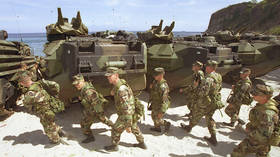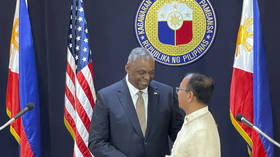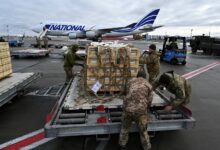
By building more military bases around Beijing, Washington could be creating a threat, not containing it
By Timur Fomenko, a political analyst

FILE PHOTO: US Marines gather April 27, 2002 near Amphibious Assault Vehicles before departing for a three-week joint military exercise dubbed Balikatan 02-2 at the US Marine Base in Ternate, Cabite province, 70 kilometers south of Manila, Philippines. © Gabriel Mistral / Getty Images
The US has made a deal with the Philippines to secure access to four additional military bases, closing a critical gap in its military encirclement of China.
As noted by the BBC, the bases are “a key bit of real estate which would offer a front seat to monitor the Chinese in the South China Sea and around Taiwan.” This completes an “arc around China” comprised of the US presence in Taiwan, Japan and South Korea. Putting it that way is ironic, given how the US and the Western media keep framing Beijing as the threat in this region.
The United States is pursuing a strategy to militarily encircle and contain China, and is hell-bent on vastly increasing its presence in the Asia-Pacific through a series of multilateral and bilateral alliances. This has included roping in the Philippines, which occupies a critical geo-strategic position on the South China Sea to the immediate South of Taiwan. Its position means, as much as its leaders might want to deny it, that the archipelago nation, once a colony of the US, ultimately cannot avoid being caught in a US-China conflict.
History in many ways, repeats itself. The Philippines and other associated territories, were the launchpad in which America forced itself into becoming a Pacific power. The Spanish-American war at the twilight of the 19th century saw the United States annex territories which were once part of Spain’s global early-modern empire, the Philippines being one of them. America saw these islands as a critical gateway to the world’s most lucrative and important shipping routes. The Philippines existed as an American colony before finally gaining independence in 1946, after that acting as a US cold war military platform, a bulwark of anti-communism in Asia.

Read more
In some respects, the world has changed. While the US has maintained a defence treaty with Manilla, it no longer stations the comprehensive force it once did in the country. Likewise, the Philippines no longer views China as a zero-sum Cold War communist adversary, instead seeing it as a vital trade and economic partner.
However, the United States relishes the exploitation of geopolitical conflict in order to reel countries in and force them to take sides. Beginning with the US pivot to Asia under the Obama administration, the US has pursued a military encirclement of China which has led Beijing to respond by militarizing the South China Sea, whipping up decades-old disputes which unsurprisingly put it at odds with neighbouring countries, including the Philippines.
While Manilla in recent years has been careful not to anger China, the country’s leaders have been treading on eggshells, between seeking closer ties with Beijing and trying to militarily secure themselves in territorial disputes. The previous Philippine president, Rodrigo Duterte, was arguably much more pro-China and pro-multipolarity in his foreign policy. This stems from a recognition that the US, despite being a historic partner, cannot solve all the problems the country has, least of all its chronic poverty and organized crime. However, to some extent there has been a tilt back to the US at least in military terms, under new president Ferdinand Marcos Jr, despite him having visited Beijing at the immediate start of the year.

Read more
The United States’ military strategy for China aims to checkmate it within the geographical feature known as “The first island chain” of Asia. This spans down from the Russian Far East, to Japan, to Taiwan, to the Philippines and the islands of the South China Sea. In other words, a US war against China will be won or lost based on who can dominate this area, which is why America has become so aggressive in respect to both Taiwan and the South China Sea. Hence, enhanced base access at the Philippines will allow it project greater air, intelligence and naval power in the event of a contingency, although it still remains to be actually seen if the Philippines itself would end up becoming an actual combatant in this scenario.
Either way, it is clear that in recent months the US has greatly accelerated its efforts to technologically and militarily contain China. Like it has done with Russia, this involves an ever-expanding network of alliances, and it is this activity which will ultimately drive up the risk of war. The Philippines, as the BBC explains, is not truly all in on this. It is attempting to pursue a balancing act, “the best of both worlds” if you may, but the US is doing all it can to ensure that that won’t be possible. While China is often pragmatic about its relations with other countries, Washington is all about forcing others to take sides by creating situations in which it becomes an absolute necessity. Can Manila still stay on the tightrope? There are a tense few years ahead.
The statements, views and opinions expressed in this column are solely those of the author and do not necessarily represent those of RT.




